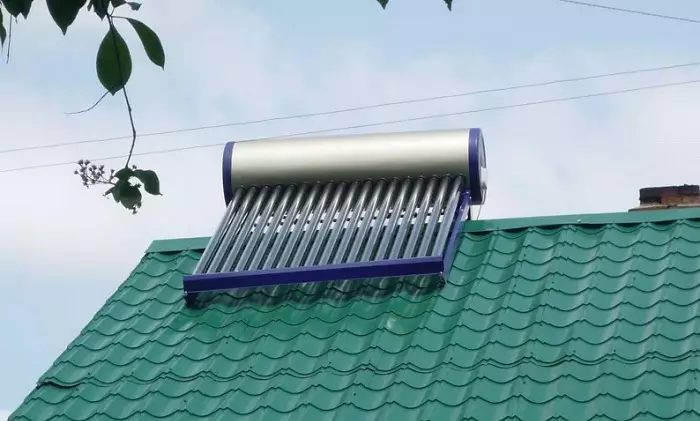
The solar water heater is a type of collector that accumulates solar radiation, converting it to heat, and produces hot water for consumer needs. The idea of using solar energy for water heating has long arose. So, the prototype of a modern solar water heater was created in the XVIII century in Switzerland. To date, this method of water heating is quite popular. The world leader on the use and production of solar heaters is traditionally China. In this country, 60 million households use solar energy for water heating. And in Israel, 85% of apartments have solar heaters. Moreover, their use is regulated by law, which has been valid since 1976, and obliges to build housing using such systems.
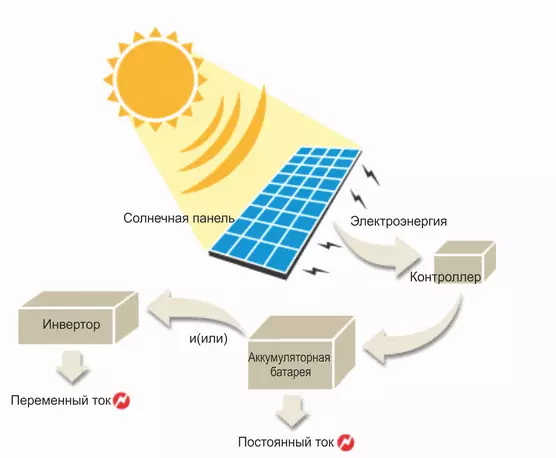
Scheme of the solar photoelectric system.
Water heaters have several advantages. First, they allow if not to be eliminated at all, then significantly reduce the consumption of traditional energy carriers, such as gas and electricity. Secondly, they reduce carbon dioxide emissions in the amount, directly proportional to savoible energy, thus reducing the greenhouse effect.
Buck for water heating with their own hands
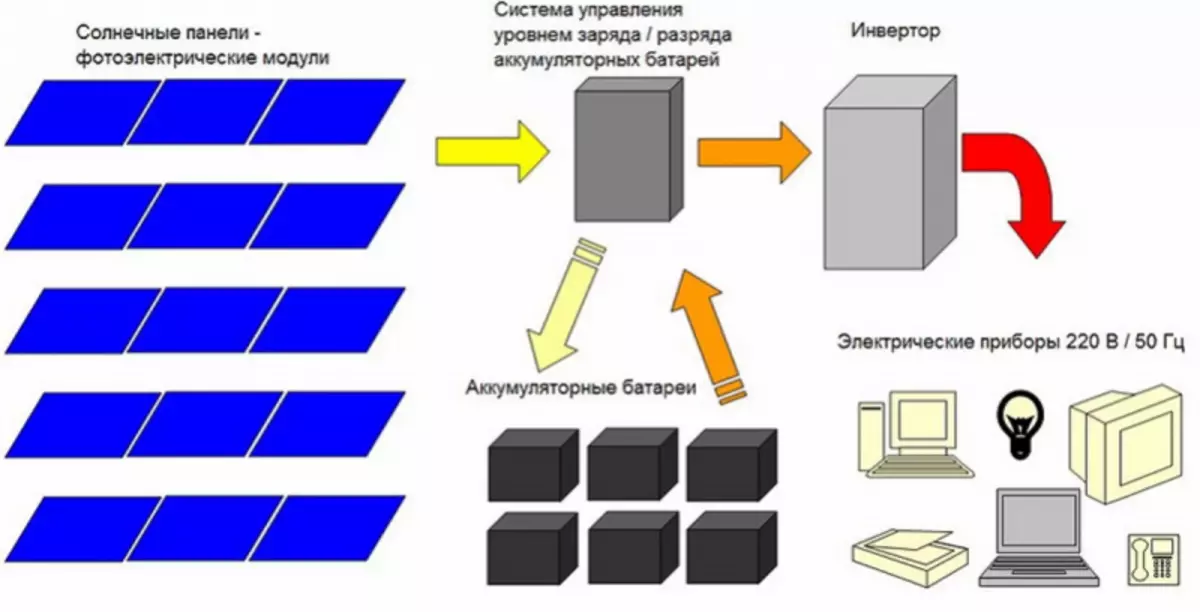
Scheme of solar modules.
The most common solar heater is a summer shower. You can construct such a hot water system with your own hands. It is completely easy. The basis of it is a tank for water, which is heated by solar radiation. Despite its primitiveness, such a structure is quite capable of satisfying the need for hot water in the warm season.
The biggest disadvantage of this method of heating is that, despite the sufficiently high temperature of the water in the tank during the day (sometimes up to 45 ° C), it falls overnight. In order to reduce the loss of heat at night, it is necessary to either insulate the tank overnight, or merge the remnants of hot water into a warmed tank. Such a tank can serve as gas or electric boilers, widely used in households. The choice of boiler as a drive is justified also because on a cloudy day the water in the tank will not warm up 30ºС, and in any case it has to warm.
Such a heater made by his own hands will serve as a reliable and economical way to heal in the summer and will quickly pay for itself.
Choosing this type of solar heater, it is necessary to take into account the several drawbacks:
- the need to fill daily and merge the tank;
- On a cloudy day, water in the tank is not heated above 30ºС.
Article on the topic: Heat Sensor: how to connect the thermostat
Installation of water tank
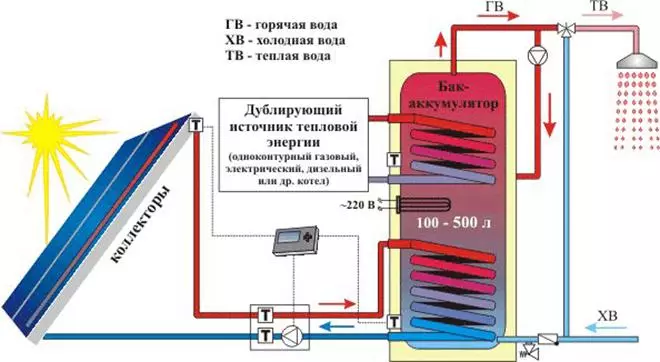
Scheme of water heating heliosystem.
For the construction of a solar water tank, we will need it:
- heating tank;
- boiler;
- Water pipe with three cranes;
- Water level sensor.
You can use any water tank as a heating tank: steel barrel, cube or even a large diameter pipe. However, the most convenient for installation and use is a special polyethylene tank for the summer soul with a volume of up to 300 liters. It has a flat shape, light weight, painted black, not rust. All this provides rational heat-absorption and simple installation with their own hands. For water supply, metalplastic or polypropylene pipes for cold water should be selected. The water level sensor is attached on the tank cover and is used to control its filling level. Mounting and operation scheme of this system is shown in the figure.
To fill the heating tank, it is necessary to close the crane 3. Crane 1 and 2 remain in the open position. After filling in the capacity, the pressure plumbing is overlapped by a crane 1. At the end of the day, the heated water is merged into the boiler by opening the crane 3. If the heater is not necessary, the crane 3 should be overlapped and use a boiler in normal mode.
Passive water heating system using solar collector
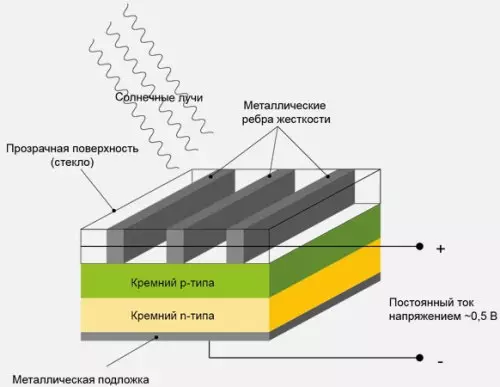
Scheme of the principle of operation and device of the solar battery.
If the water heating tank is used exclusively in the warm season, then the solar collector of passive type makes it possible to extend the period of using solar energy from March to October. Passive such system is called because the pump is not used in its design. The need to draw the water by boiler in this case too. However, substantial energy savings are indisputable.
The main element in such a water heating system is a solar collector. In order to achieve maximum performance indicators of this element, along with reliability and simplicity of assembly, special attention should be paid to the heat exchanger. Practice has shown that steel or copper thin-walled pipes are the best heat exchanger material. The use of metal-plastic pipes is also permissible, but their minus is the probability of deformation when exposed to solar heat, as well as the likelihood of water leaks due to a variety of compounds. If there is an old, unnecessary refrigerator in the house, then instead of pipes you can use his serpentine.
Assembly and installation of a solar water heater using a garden hose with your own hands
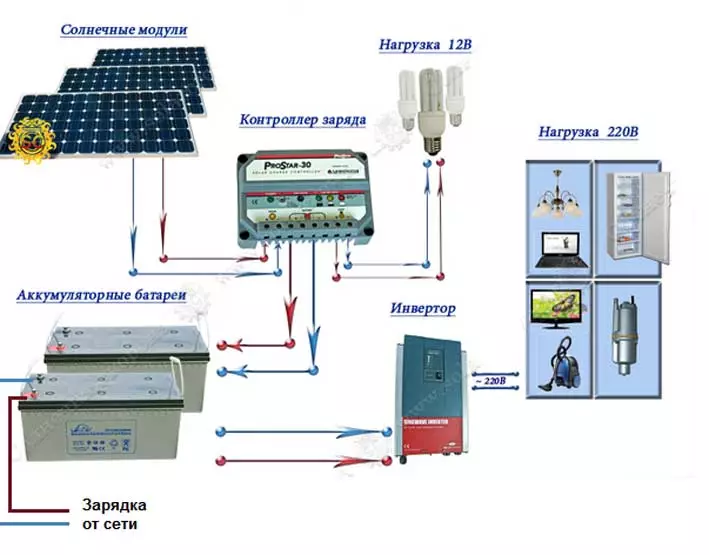
Scheme of the power grid when using solar panels.
To reduce the cost of the construction of a solar collector and reduce its weight, metal pipes can be replaced with a simple garden hose, twisting it in a spiral with their own hands. His advantage is the absence of additional compounds, eliminating the leakage, low cost, the possibility of summing up water from the collector directly to the pipeline.
Article on the topic: Is it possible to additionally paint fliesline wallpaper
For the construction of a solar water heater with a collector from the garden hose we will need:
- window glass;
- garden hose;
- Polypropylene or cellular polycarbonate sheet for the base.
Material of the hose - rubber or reinforced PVC. Inner diameter - not less than 19 mm to reduce the level of hydraulic resistance. The thickness of the hose wall is not less than 2.5 mm. When choosing a color to give preference to black or dark tones to improve heat. The glass must be chosen by window, without selective coatings, as the polymer film and organic glass poorly delay long-wave radiation, and the so-called I-glass reflects shortwave. When choosing between single and double glazing, the rule should be guided by the rule: if the heater will be used more often in the warm season, then preference is better to give single glazing if the cold season is double. The gap between the foam and glass can be sealed with their own hands using silicone, water-based glue or simple foam pad. The distance between the glass and the hose is 1.2- 2 mm.
The principle of action of such a water heater lies in a kind of thermal trap: the sun's rays fall through the glass, the hose is heated, which, in turn, also gives the heat, persistent inside the water heater housing under the condition of its tightness. As the basis for the water heater, instead of a foam sheet, a wooden framework with a solid bottom and a layer between the bottom and the collector in the form of a foil and a rubber rug can be used.
Installation of the solar water heater from the garden hose is depicted in the diagram.
When installing the water heater, you should know with your own hands that the boiler must be at a level of at least 60 cm above the upper edge of the solar collector to provide a stable thermophone effect. The length of the supply pipe between the collector and the boiler must be as short to reduce the friction force when flowing water.
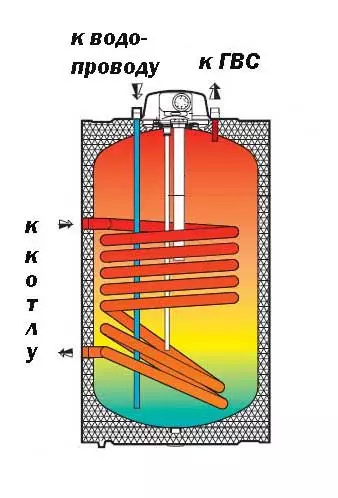
Scheme of coil for boiler.
To reduce heat loss, the conclusions of the hose and the pipeline should be thermally insulated. For thermal insulation indoors, as well as in short portions of the pipeline, the insulation of polyethylene foam for these purposes can be used for these purposes. For thermal insulation of external conclusions and pipelines of more than 3 m, it is better to use foil polyurethane foam. To connect the hose to the pipeline, the clamp is used for rubber pipes.
First you need to fill the hose with water and release air out of it: we close the crane 2 and open the crane of hot water 6. The water from the pressure water supply 1 falls into the solar collector 1. When air bubbles disappear, we will disappear in the drain water, we conclude that there are no air traffic jams in the collector . Then we open the crane 2, and the cold water under the action of the thermosifone effect enters the heater. To stop the collector's work, overlapping a crane 3. A minus of this solar water heater is the need to periodically turn on and off the water supply to the collector of the crane 3, as well as the use of a boiler to heal water at the end of the day in cloudy weather and during the cold season. Otherwise, it ceases to circulate.
Article on the topic: How to quickly remove vinyl wallpaper from the walls
Calculation of the performance of the passive water heater
To calculate the performance of the passive water heater, the following indicators will be needed:- hose diameter;
- air temperature;
- The average number of sunny hours for the period.
It is known that 1 m of the hose, the outer diameter of which is 25 mm, at air temperature +25 ºС on a sunny day heats 3.5 liters of water to a temperature of +45 ºС, and with an increase in air temperature to +32 ºС under the same conditions - +50 ºС. The average annual indicator of the number of sunshine for Moscow and the Moscow region is 5.5 hours, taking into account cloudy days. Thus, with a length of the hose 10 m in the collector, the performance will be: 3.5 * 10 * 5.5 = 192.5 l of heated water. The lower boundary of the air temperature at which the collector's work is useful, is +5 ºС. When the temperature decreases, water from the collector must be merged.
The efficiency of using a solar water heater
There is an opinion that Russia is not suitable for the use of solar energy to heal water due to a sufficiently cold climate. However, this is not the case. In order to determine whether solar heaters are effective in our latitudes, we will operate with such a concept as insolation (the amount of solar energy falling on the ground surface). On the territory of Russia, the annual insolation rate ranges from 800 to 1900 kW / m2. In the Moscow region, this indicator is 1100 kWh / m2. For example, in Germany, with a similar insolation indicator, such systems cover the total area of more than 6 million m2.
Solar heaters are fully applicable in the average latitudes of our country. They are able to save up to 60% of electricity. According to studies conducted by the German Institute of Construction Physics, the average family of 4 people consumes an average of 4400 kWh in a year. Such amounts of energy can produce solar modules with an area of only 34 m2. And even if the solar water heater made by its own hands will give way to an analogue of industrial production, energy savings still remains tangible.
